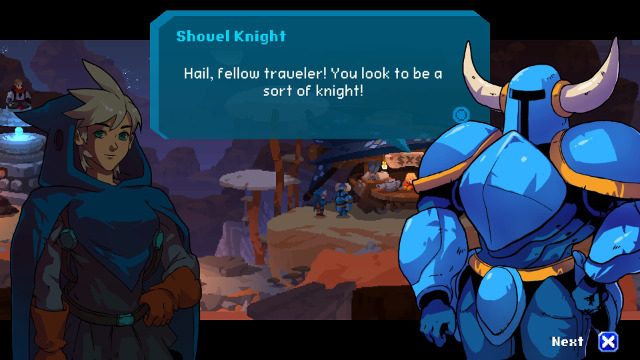Developed by GUTS Department, Aegis Defenders was Kickstarted in 2014, and finally, three years later and with the addition of Humble Indie Bundle as a publisher, we have been rewarded with this 2D action platformer that prominently features puzzles and centers around tower defense gameplay. If that previous sentence didn’t make it abundantly clear, Aegis Defenders wears many hats.
The Setup & Story

The game does a great job of not taking itself too seriously.
You start out the game playing as Clu, a teenage girl, and her grandpa, Bart, as they journey through ancient ruins looking for items from a long lost civilization that can be scrapped. Things quickly go awry once they find a working service robot, known as a Kobo, that leads them to an ancient war machine known as the Aegis. Said war machine would be very valuable to a certain dictator, so your mission quickly becomes about stopping the Aegis from falling into the wrong hands; thus you become an Aegis defender.
The game’s story starts off on strong footing and even evokes a Studio Ghibli-like sense of wonder early on. But as the story wears on, a handful of tropes, as well as underdeveloped characters and themes, make the story feel more like an intriguing backdrop for the gameplay as opposed to the driving force that it was early on.
Gameplay
The Macro
Aegis Defenders follows a formula. You have your base camp where you upgrade items, talk to teammates, and partake in the game’s “Hall of Builders,” which is a survival mode that lasts as long as it takes for all the Kickstarter backers’ names to pass on the screen.
On the world map, you select your mission. Each mission consists of a series of puzzles as well as a unique mechanic that’s introduced early on and which is iterated upon until finally being implemented into the tower defense section that comes at the end of every mission. These levels also have three bonus goals: complete the mission, don’t let the objective take damage, and collect all the items in the level. Throw in some bonus missions where you get to earn items from guest characters, and a couple of levels where you are guiding a vehicle through a level, and you have basically encapsulated the whole game’s structure.

My new Hall of Builders High Score is like 2,362, but who’s counting?
And most of this works relatively well. The base serves its purpose while also letting you bond with your characters, although I couldn’t help but feel like there should have been more downtime dialogue. The Hall of Builders was something I played through dozens of times even after I’d earned the highest reward; in fact, I’d go so far as to say they should have built upon this concept as its own mode. For an action game, the puzzles are generally of a high quality and do a good job of both teaching you about the game’s mechanics and using them in interesting ways. The bonus missions are fun and force you to use characters in ways that you wouldn’t anywhere else in the game. However, one is an obstacle course that caused dozens of deaths, so such drastically experimental gameplay does not come without its caveats.
The Party

Now that we’ve gone over the macro, let’s dig into the details of gameplay. Your party eventually balloons from two to four characters, with each having his or her own unique special ability, weapons, and aforementioned towers. Characters can create their own unique towers by using their own personal resources found throughout the levels. In turn, these towers can be fused together to form new and entirely unique towers.
For instance, Clu, a stereotypical archer/huntress-type character, can place powerful single-use mines that become spikes when fused together. Fusing these same mines with her Grandpa’s building block creates a turret that shoots bullets in a cone shape. Fusing with the monk’s torch creates a spirit that shoots ice balls that freeze enemies. It’s a fun system that places emphasis on the characters’ uniqueness while never feeling alienating when switching between them. This was undoubtedly one of my favorite parts of the game.
Controlling the Party
As mentioned above, you have a large party and are allowed to switch between characters. You’re also given some extra control over them via the L2 trigger (on the PS4 anyway). Pressing L2 toggles between having your teammates follow you as translucent, inactive observers and having them wait in their current spots as active defenders that will fight off enemies. Sadly, it doesn’t take long for this system’s problems to become apparent.
I started the game out with two-player couch co-op (which activates extremely smoothly at the main menu, which I greatly appreciate since so many co-op games force you to jump through hoops), so this problem didn’t rear its ugly head until the third party member joined. But after we’d spent an entire level confused and bewildered, we knew that this was one of the game’s greatest stumbling blocks.
AI Companions *shivers*

I’m using this to insinuate that I’m crying from bad AI design.
You see, your AI companions are rather dumb and have absolutely no initiative of their own. While this is good in some ways — you really don’t need their help during the platforming sessions other than to stand on a switch — it manifests itself in the worst ways possible during the tower defense segments.
Let’s go down a list of their inadequacies:
- Bart is a melee character but won’t actually move into melee range. In fact, he won’t even attack when enemies get near; he just guards. While this can be a life-saving strategy at times, it also means he can’t be left alone because he’ll never do any damage, nor will he ever utilize the large knockback inherent to his weapons.
- Bart is also the builder. While everyone has their own towers, it is Bart that can speed up their fusion and repair them. But Bart won’t do that on his own unless you first move him on top of the tower, which largely defeats the purpose. He will not so much as take one step forward in an effort to help you out with these tasks.
- Similarly, despite having one minute between waves, your allies will not help you gather the resources necessary to build the towers that will be needed for the coming wave.
- AI companions also go down for several seconds after taking a hit, meaning they can let a copious number of enemies past them when they’re supposed to be defending.
- The game also uses a color-coded system whereby hitting a foe with the correct color deals triple damage, but AI allies won’t switch to the proper weapon, meaning you have to babysit them.
- AI allies will also not go out of their way to adequately defend against flying enemies, and since the game doesn’t bother to tell you when they are coming or where they are coming from, you just have to be on your toes.
I understand what the developers were trying to do. They wanted you to multi-task and use the limitations of your allies as a creative tool to solve the strategic problems placed before you. But the limitations on your allies were way too great for them to be useful tools. When I place three of them on one lane, while I am by myself guarding two lanes on the opposite side of the map, I shouldn’t have to swap over there to save them every five seconds.

There’s even a Shovel Knight cameo.
Combine this with two problems I alluded to above — a one-minute preparation time and the lack of an enemy forecast — and you have a lot of yelling; just ask my family.
I’d also be remiss if I didn’t mention the three levels where your objective is moving — two where you have to protect vehicles, and one where you are on an elevator — which are extremely difficult because they up the amount of multitasking to an ungodly level. I died so many times on the first one that I was borderline ready to call my friend up and demand he come help me beat the level. Ultimately, after having died dozens of times, I learned the patterns and was able to get through, but it was still only by the skin of my teeth.
Conclusion
While that last section may have sounded really bad, and the game is admittedly rough around the edges in some places, I think there is plenty to be loved here. Couch co-op can be great fun, and not merely because it’s always fun to play with other people, but because it helps mitigate the ineptitude of the AI while forcing you to work together to do all of those things the AI won’t help you with. Who would have thought that actually being forced to work with and help other humans could be pretty fun? Moreover, while the game is very difficult (there really needs to be a difficulty level lower than Normal), it can be extremely rewarding to simply beat many of these levels, and much more so to actually earn all of the bonuses for each level.

We all have a process. For me, that just means there’s jazz everywhere.
Tower defense games, especially ones that are mashed up with action elements, have always been a darling of mine. At their best, they combine strategy, skill, and multitasking into this beautiful mess that I absolutely love, not to mention the mashup’s relative rarity keeps them fresh. But even with these rose-tinted glasses on, I must admit that Aegis Defenders‘ unyielding difficulty makes it a niche product. In this way, I think the Aegis is an adequate metaphor for the game itself. When seen only from the outside, its inherent danger belies a core that’s worth so much more. You just have to fight a bloodthirsty dictator hellbent on destroying the world’s order to uncover it.
—
A review code was provided for Aegis Defenders by the developers.






Published: Feb 8, 2018 03:24 am